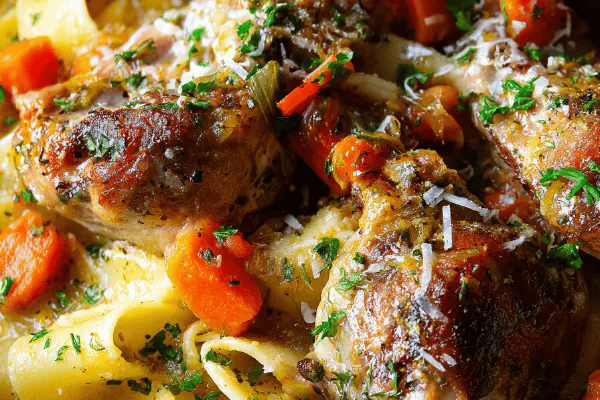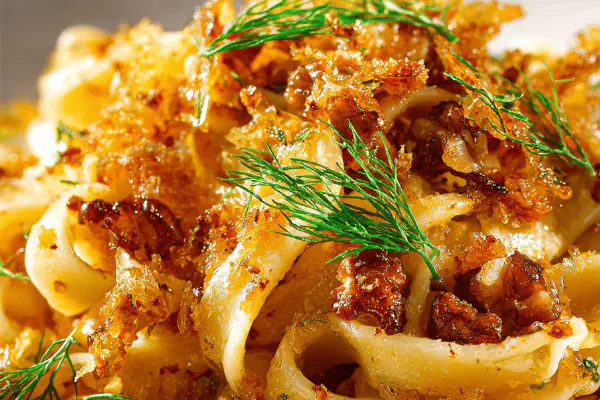Braised Rabbit Pappardelle

E
By Emma
Certified Culinary Professional
•
Recipe tested & approved
Braised pieces of rabbit cooked in butter, white wine, and chicken broth with carrots, onion, garlic. Thickened with flour. Tossed with pappardelle pasta flavored with fresh parsley, rosemary, thyme, and topped with aged pecorino cheese. Slow simmered until tender. Rustic Italian style pasta main dish. No nuts, lactose, or eggs. Slightly adapted traditional ragù technique with altered spices and quantities.
Prep:
35 min
Cook:
Total:
Servings:
4 servings
#Italian
#Pasta
#Rabbit
#Ragù
#Slow cooked
#Herbs
#Rustic
#Main course
Rabbit slow-cooked, chunks braised in wine and stock. Parsnips over carrots. Butter swapped for olive oil. Herbs changed: rosemary stays. Sage joins thyme and parsley. Flour thickens sauce, adds body. Pappardelles fresh or dried, holds ragù well. Pecorino romano, sharper than parmigiano, pushes flavors. Fat content dropped, cooking times shaved a bit. Salt and pepper throughout because flavor needs backbone. Rustic, hearty. A meal in itself. No nuts, no lactose apart from cheese, no eggs. The rabbit meat pulls away from bone tender but not mushy. The sauce thick, aromatic. Chewy pasta strands cradle every bit of sauce. Jump into herbal, meaty, rich layers.
Ingredients
Ragù
- 1 rabbit, cut into 6 pieces (or 4 rabbit legs)
- 45 ml (3 tbsp) olive oil
- 3 parsnips, peeled and diced into 0.5 cm (¼ in) cubes
- 1 medium onion, chopped
- 3 cloves garlic, minced
- 20 ml (1 ½ tbsp) whole wheat flour
- 150 ml (⅔ cup) dry white wine
- 900 ml (3 ¾ cups) chicken stock
- 1 sprig fresh rosemary
- Salt and black pepper
Pasta
- 400 g (14 oz) fresh pappardelle
- 25 ml (1 ½ tbsp) chopped flat-leaf parsley
- 5 ml (1 tsp) chopped fresh sage
- 5 ml (1 tsp) chopped fresh thyme
- 100 ml (⅓ cup) grated pecorino romano cheese
About the ingredients
Rabbit works best in cuts that cook evenly, 6 pieces chosen for quicker braising. Parsnips swap carrots for slightly sweeter, earthier note. Olive oil used instead of butter for lighter mouthfeel and added fragrance, fits the reduced fat goal. Flour switched to whole wheat for nuttier element and slight thickening without losing silkiness. Wine quantity upped for stronger body. Fresh herbs calibrated: sage added for depth alongside rosemary and thyme. Pecorino romano chosen over parmigiano for bolder saltiness, balancing gentle rabbit flavor. Pasta quantity raised slightly to feed four generously. Seasoning is kept simple—salt, pepper—letting ingredients shine.
Method
Ragù
- 1. Heat olive oil in large heavy-bottom pan over medium-high heat. Brown rabbit pieces until golden on all sides. Season with salt and pepper. Remove and set aside.
- 2. In same pan, sauté diced parsnips, onion, and garlic until softened, about 7 minutes. Stir in whole wheat flour and cook 1 ½ minutes, stirring constantly.
- 3. Pour in white wine, increase heat and boil, scraping brown bits, until reduced by half.
- 4. Add chicken stock and fresh rosemary. Return rabbit pieces to pan. Bring to boil, reduce to low heat. Cover loosely and simmer gently about 1 hour 25 minutes until meat tender.
- 5. Remove rabbit and rosemary sprig. Debone meat, shred or chop coarsely. Return meat to sauce. Season to taste with salt and pepper.
Pasta
- 6. Cook pappardelle in well salted boiling water until al dente, about 3-4 minutes if fresh. Drain and toss lightly with olive oil if waiting.
- 7. Fold pasta, chopped parsley, sage, and thyme into ragù in pan. Warm together over low heat until heated through.
- 8. Sprinkle pecorino romano on top. Stir briefly. Adjust seasoning with pepper or salt. Serve immediately.
Cooking tips
Brown rabbit in hot oil first. Don’t crowd pan, do in batches if needed for color. Cooking vegetables slowly allows natural sugars to release, parsnips soften. Stir flour well to avoid lumps; cook slightly to toast and remove raw taste. Wine reduction takes patience—no rushing or sauce stays thin. Keep simmer gentle so rabbit doesn’t dry out, tight lid reduces evaporation but leaves room for steam escape. Debone carefully to keep chunks manageable, add back to sauce for melding. Pasta cooking is critical—fresh cooks fast, drain thoroughly. Toss with a little oil if not served immediately to prevent sticking. Herbs added after pasta to preserve bright aroma. Cheese folded in at end melts slightly but doesn’t overwhelm. Final taste test adjusts salt and pepper, sometimes a pinch more cheese for salty punch.
Chef's notes
- 💡 Brown the rabbit in batches to get good crust, don’t crowd pan. Hot olive oil, medium-high heat, turn pieces for even color. Browning locks juices, adds flavor depth. Avoid gray spots; takes time but essential.
- 💡 Cook veggies slow over medium heat. Parsnips soften but keep shape. Onions translucent, garlic fragrant, careful not to burn. Stir constantly once flour added, toast for 90 seconds to remove rawness.
- 💡 Wine reduction key. Pour in, turn heat to high. Scrape pan bottom to lift browned bits. Reduce liquid by half for concentrated flavor. Don’t rush. Thin sauce won’t thicken with flour later.
- 💡 Simmer rabbit gently with lid tilted. Vigorous boil dries meat out. Steam escape needed to avoid watery sauce. One hour 25 minutes, test tenderness, meat should pull soft but stay intact.
- 💡 Deboning after cooking must keep chunks manageable. Shred or chop coarsely, large enough to see texture. Return to sauce, simmer briefly for flavors to meld before pasta joins.
Common questions
Can I use dried pappardelle?
Yes but adjust cook time, usually longer. Fresh cooks 3 to 4 minutes. Dried tougher, holds sauce differently. Toss in oil to prevent stick if waiting.
What if no white wine?
Substitute with extra chicken stock plus splash of lemon juice or apple cider vinegar. Lowers richness but keeps acidity balance. Avoid wine flavor if preferred.
Why whole wheat flour?
Adds nuttiness and thicker sauce body, different than white flour’s silkiness. Toast well in oil for flavor, avoid lumps. Keeps sauce earthy with slight texture.
How to store leftovers?
Cool quickly. Refrigerate in airtight container up to 3 days. Freeze if needed, separate pasta and ragù if possible. Reheat gently to avoid drying pasta or tough rabbit.



